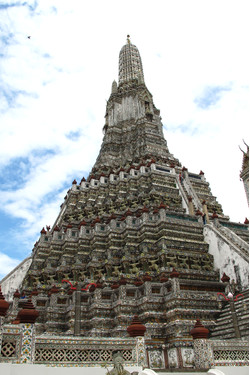Artwork Search
Arts in Southeast Asia Database
Phra Prang Wat Aroonrajwararam
Keywords : Prang, Wat Aroonrajwararam Rachaworamahaviharn, Wat Chaeng, Wat Makok
| Site common name | Wat Aroonrajwararam Rachaworamahaviharn |
|---|---|
| Site alternative name | Wat Chaeng, Wat Makok |
| Type of artwork | Architecture |
| Sub district | Wat Arun |
| District | Khet Bangkok Yai |
| Province | Bangkok |
| Region | Central |
| Country | Thailand |
| Geographic Coordinates Decimal degree | Lat : 13.743715 Long : 100.488953 |
| Geographic Coordinates UTM | Zone : 47 P Hemisphere : N E : 660986.04 N : 1519879.85 |
| Place of artwork | In the sacred zone |
| History of production | The former stupa was built in the Ayudhya period. King Rama II enlarged its construction and the work was finished in the reign of King Rama III. |
|---|---|
| Conservation | Phra Prang Wat Aroonrajwararam was listed and declared an ancient monument in the Government Gazette, no.66 on 64 November 1949. The restoration works were in the reign of King Rama IV and V, while the major restoration was in 1999 AD in the reign of King Rama IX. The current restoration has begun since 2013 AD by the Fine Arts Department and the Department of Religious Affiars. |
| Size | 1 sen 13 wa 1 sok 1 kueb 1 niew in height and the pedestal is 5 sen 17 wa width |
| Art | Phra Prang Wat Aroonrajwararam shows the further Ayutthaya prang-typed stupa, which the platform is wider and curved pyramidal pedestals decorated by Pholbaek figures. The anda has Indra riding Erawan elephant, instead of buddha image, in the niche on each side, whose top lies a smaller prang. The Indra Pholbaek figures lead the scholar to believe that the stupa should be related to Culamani stupa or Mount Sumeru at the centre of the universe. The top of the stupa is decorated by tiered Kleep Khanoon and the sum of the peaks are five. |
| Key academic information | Phra Prang Wat Aroonrajwararam was built in the Ayudhya period. King Rama II would like to enlarge the stupa for being the principal stupa of the capital city. However, he died when the project just began at the basement. Therefore, King Rama III continued the work, which would later be completed as the largest Prang-typed stupa of Rattanakosin kingdom.When the construction was completed in the reign of King Rama III, he ordered to place a Nobhashul finial on the top of the stupa and a crown, which was originally made for bejeweled buddha of Wat Nang Nong, on the peak. |
| Period | Historical Period |
| Art period | Rattanakosin |
| Age | 19th century AD |
| Religion | Buddhism |
| Sect | Theravada |
| Religion and belief | Theravada Buddhism |
| Type of License | Attribution-NonCommercial-NoDerivs (CC BY-NC-ND) |
|---|---|
| Rights | Princess Maha Chakri Sirindhorn Anthropology Centre |
| Date of record creation | 2015-05-26 |
| Record creator | Patsaweesiri Premkulanan |
| Bibliography | คณะกรรมการดำเนินงานจัดทำหนังสือสมุดภาพวัดอรุณราชวรารามราชวรมหาวิหาร.สมุดภาพวัดอรุณราชวราราม.กรุงเทพฯ : คณะกรรมการฯ , 2534. ศิลปากร,กรม.ทะเบียนโบราณสถาน. กรุงเทพฯ: กรมศิลปากร, 2532. สันติ เล็กสุขุม. ข้อมูลกับมุมมอง : ศิลปะรัตนโกสินทร์. กรุงเทพฯ : เมืองโบราณ, 2548. |


